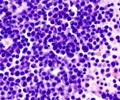Scientists have created a viable technology to improve the detection of leukemia cells in bone marrow.
A viable technology to improve the detection of leukemia cells in bone marrow has been developed by scientists.
Superconducting Quantum Interference Device (SQUID) enhanced the ability to rapidly quantify the amount of nanoparticle bound tumor cells in a sample at least 10 fold, and increased sensitivity of minimal residual disease measurements. Results of this proof-of-concept study are published in Cancer Research, a journal of the American Association for Cancer Research."This promises to significantly enhance the detection for residual disease in leukemia and other cancers," said lead scientist Richard S. Larson, M.D., Ph.D., vice president for translation research at the University of New Mexico Health Science Center. "Coupling nanotechnology can be employed in common techniques to enhance its utility."
These findings are a result of a collaborative research effort between Senior Scientific, LLC, and the University of New Mexico. The study was funded by a small business innovation grant awarded by the National Cancer Institute.
Previous studies have indicated that the magnetic needle can collect approximately 80 percent of leukemia cells in a bone marrow sample in a matter of minutes, according to Edward R. Flynn, Ph.D., president and CEO of Senior Scientific, LLC.
Source-Eurekalert
RAS














